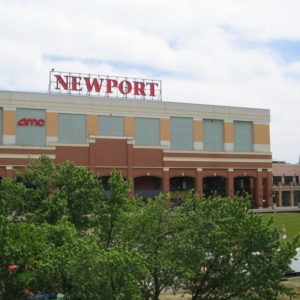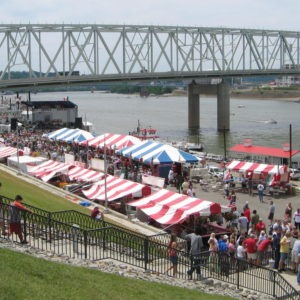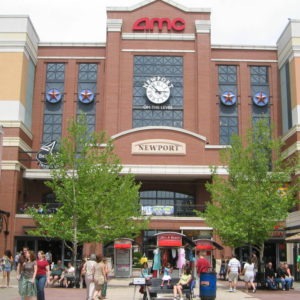Newport, KY in 2051 – America’s New Innovation Hub

Come on a journey to America’s Heartland and visit Newport, Kentucky in the year 2051. Here we have a tale of a small city that makes a bold transformation to become the country’s innovation incubator. But, how did we reach this point? Is the development of their infrastructure sustainable and repeatable? And, what practices can be applied to other cities as well?
First, let’s figure out how we arrived here. We suppose that Newport will face a crossroads during the 2020s and will think about how to best position their city for long-term success. We posit that city officials will seek to future proof their community and take drastic steps to not only stay relevant, but to also become a leader among cities across the world.
We think that Newport will start to heavily invest in innovative ideas that will help spur growth and attract new residents.
Our idea is that they will not shy away from unconventional methods and will actually start to promote itself as a living laboratory where new ideas can germinate. Newport will then start to gain notoriety as America’s incubation grounds for breakthrough ideas in urban planning and city life.
Of course, these are all hypothetical suggestions that will take years to plan and willing consortiums to actually agree to and implement. We understand that not all parts of this future vision will be feasible to develop since we are taking some significant leaps in our assumptions of how society will evolve.
But, take these disclaimers into consideration and just bring your imagination to the future in Newport, Kentucky in the year 2051.
The Turnaround – Newport in 2028

Let’s start with the history of Newport. The town of Newport was founded in 1795 and it slowly became the 3rd largest city in all of Kentucky by the 1900s. Its population peaked in the 1950s, with over 30,000 residents calling Newport home.
Since then, it has faced a slow decline as it has been affected by the general flight from the Midwest as well as competition from its direct neighbors like Cincinnati and Covington.
In the 2000s, the city sought to reimage itself as a more family friendly city and built Newport on the Levee on the waterfront. This $40 million investment has proven to be adequate, but residents continue to depart at a rate of about 10% per year.
In the 2020s, the city’s population stood at roughly 15,000 and new plans were made to continue to expand downtown Newport with a new mixed-use development called Ovation that would be built on the western banks of the city. This development coincides with an update to Newport on the Levee that includes a shipping container park and a redesign of the center’s main structure, the Gallery Building.
But, starting in the mid 2020s, the city realized that it was still not enough to keep current residents from leaving and to incentivize new people to come. Newport realized its reliance on amenities offered by Cincinnati was not sufficient and it needed to elevate itself to be the focal point of the region if it wanted to thrive.
So, in 2028, Newport’s city officials agreed to rebrand the city as the innovation center of the Midwest, offering space and funding to startups and established companies that offered exciting concepts that could positively impact the city and improve the quality of life around the area.
Newport’s Dedication to Innovations
Newport realized that it could not just wait for the future to arrive. Rather, they wanted to accelerate the change that seemed to be inevitable. After their 2028 proposal, city planners started to drastically overhaul the city’s infrastructure and zoning requirements.
It became the first city in America to ban internal combustion cars and switch to a fully electric grid in 2030, a full 10 years ahead of the general pledges from other cities and regions. This switch immediately put Newport on the map as a center for progressive ideas. They also partnered with Tesla to create the first supercharging city. This included charging stations in virtually every neighborhood and retail center, solar panels on every home, and a wind farm built in the area.
The transformation of the city’s infrastructure also allowed Newport to incorporate smart elements into its framework. They installed sensors and developed programs that helped optimize its energy distribution, traffic flows, and use of public spaces.
Next, Newport took advantage of a new building material developed by a local startup that could infuse the grains of wood with different materials to allow it to perform a multitude of different functions. This new wood composite is able to mimic the strength and performance of glass or cement while also being able to actively function, such as generate electricity or absorb pollution. Newport commissioned a new mixed-use development to be constructed in its west end with this material, which was the first of its kind in the world.
They went further by planning a floating city right in the Ohio River, off the coast of Newport on the Levee. This $27 billion project was primarily funded by a new investment group that gained success through cryptocurrencies and wanted to encourage the growth of emerging technologies. Since Newport was the first city to be willing to start such a dramatic project, the investment group agreed to the initiative.
Finally, Newport pushed the development of multi-functioning spaces within its city limits. The innovation here was that it was not limited to just cycling among various uses, but it also uses that are based on the time of day and the day of the week. Their vision was to better utilize the Ovation development that saw large gaps in usage between office work and leisure activities, as well as the general utilization of city roads through the day.
Newport in the 2040s

So, how did all of these major initiatives pan out for the city? Well, we will start with the initial snowball effect it had on its reputation. You can’t just launch several progressive, billion dollar programs without getting noticed.
Newport’s daring commitment to these projects proved to the nation that they were serious about the future.
Many innovative thought leaders started to follow Newport’s progress and some started to move there.
Naturally, some startups and corporations looking to get on the cutting edge of their industries also started to set up locations in Newport.
With this strong foundation, Newport was able to garner more support and funding to ensure that the enthusiasm for their projects would not taper off.
America’s first Tesla city turned out to be a rousing success. The switch to a fully electric grid with the extensive use of solar panels reduced energy costs by 63% for the city. The development of smart city elements also helped optimize energy consumption and traffic flows, which helped reduce air pollution by 21% and commute times by 18%.
Furthermore, this smart, electric network allowed new forms of transit to start. Autonomous vehicles now ruled the roads, passing seamlessly among each other throughout the city. Newport also deployed a fleet of self-driving electric cars and buses that could be directed to virtually any part of the city, which greatly reduced the need for people to own personal vehicles.
Despite operating more cars and buses in their fleet, the city actually saved money compared to managing a traditional public transit system since the cost of electricity was far lower than the cost of gas and it was cheaper to maintain electric engines than internal combustion engines.
Meanwhile, the city’s use of the new wood composite substrate also turned out to be a major hit. The ability of this building material to take on virtually any characteristic while also actively adding a function allowed Newport to reduce building costs and improve the quality of life in areas that utilized the new materials. The designers decided to prioritize cooling and anti-pollution as its major functions.
The results were a 28% reduction in energy use to cool the building and a 40% reduction in air pollution in the immediate surroundings of the building. These promising results led the city to start retrofitting existing buildings and structures around the city with parts of this new wood.
The floating city got off to a rough start. As the first major floating city built in America, it went through several growing pains as both planners and citizens tried to solidify its vision together. It was decided that the city should be an extension of Newport on the Levee and incorporate both an above-ground and underground element that mimicked living underwater. The underground should then connect to the Levee.
The first phase of the project was to establish the underground foundation. It took 7 years to fully complete, and the initial commercial interest in it was limited. However, universities and research companies started to take a strong interest in its development as the underwater area provided deeper insights on aquatic life and how humans could live within oceans and seas.
After that, the second phase of the floating city commenced with far more support. The whole structure was turning into a space that greatly interested both private and public entities, which was perfect to help maintain support and funding for the project.
Finally, Newport’s attempt to redefine mixed-use spaces was seen as one of the top innovations of the last 50 years. Using data from their smart grid, analysts were able to pinpoint various uses during different times in each area of the city. They took this insight and developed a new model for the city, where spaces and streets would automatically change their amenities as well as their physical properties depending on the time of day and day of the week.
The city could change traffic patterns in real-time, which autonomous vehicles had no issue adapting to, and create pedestrian malls. It could also modify bike lanes to accommodate more bikers during rush hours and even increase or decrease lighting in different public spaces.
Newport in 2051
Fast forward to 2051, where Newport has firmly established itself as the leader in innovative thinking. As these projects have matured and have proven to be successful, businesses have flocked to the fertile grounds of Newport to develop their ideas. This in turn has attracted a large influx of new residents.
There have been people who moved in that wanted to secure one of the thousands of new jobs. There have also been many folks who were drawn in by the futuristic mindset of the city and wanted to live in the most modern place in America. By 2051, the city had grown larger than Cincinnati to 330,000 residents, making it the largest city in the region.
The combination of the cost savings and extra tax revenue from a larger population also allowed Newport to start wide-scale experiments with universal basic income. While this project had many doubters, it has proven to be another innovation that has given rise to unexpected benefits within the city.
With more time, residents started to cultivate their own passions and interests and used their income to establish many new businesses and services in Newport. Now, Newport was not just known as the innovation capital of the US, but also the creative center of America.
Today, Newport is seen as a shining example of how to construct a city of the future. Its electric grid and fleet of autonomous vehicles proved the viability of this new concept and is now a best practice that other cities across the nation are implementing.
The wood composite material continues to be used throughout the city, with more and more use cases popping up every day. Currently, over 60% of buildings and structures in Newport incorporate a piece of the new wood. The results have been a 31% decline in construction costs along with improvements to cooling and pollution control.
The floating city is now Newport’s main attraction. Its extensive underwater levels serve as a research hot bed and a place of heavy commercial activity.
Restaurants and hotels have been flourishing underwater as tourists flock from around the world to marvel at this unique structure.
Additionally, the above-ground portion has generated high demand among residents and companies seeking prime real estate in one of America’s strongest growing cities.
Summary – Newport Means Innovation
In just 30 short years, Newport, Kentucky was able to turn their fortunes around. But, it did not just come from luck. City officials took radical measures and pushed the envelope to get to where they are now. They took a bet on technology and it has paid off tremendously.